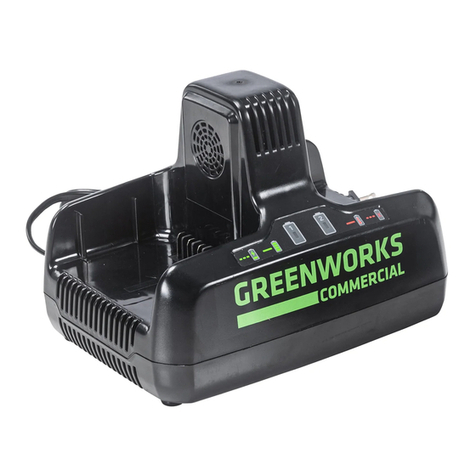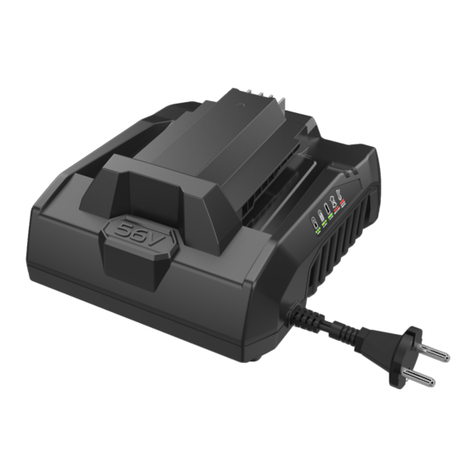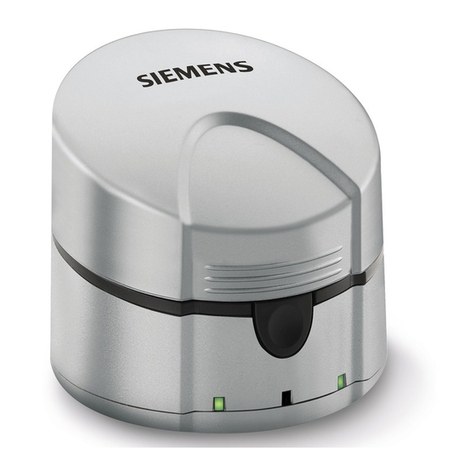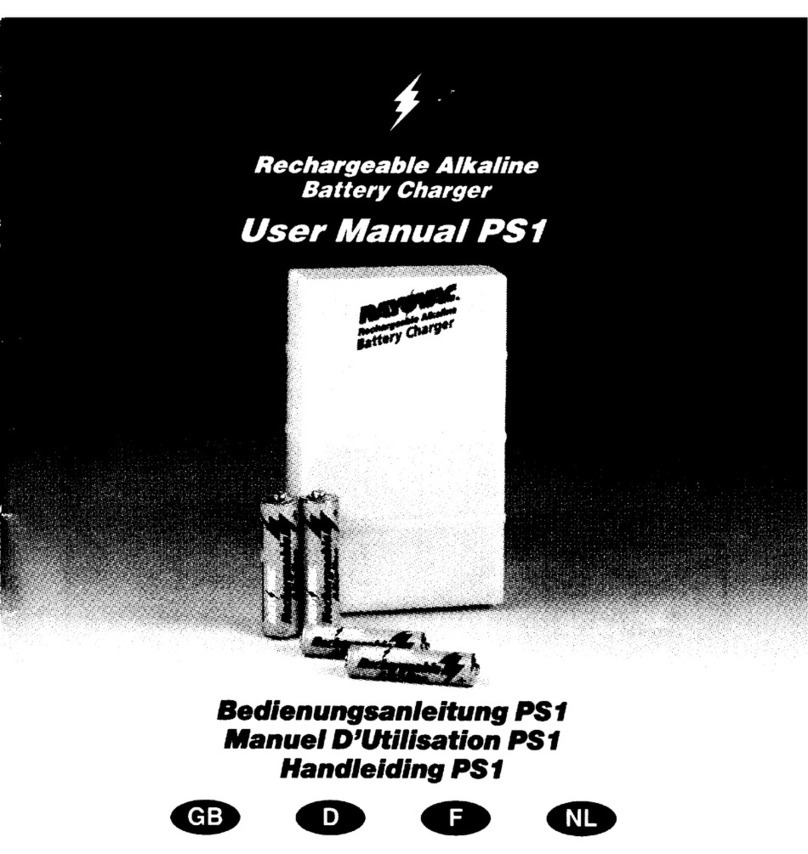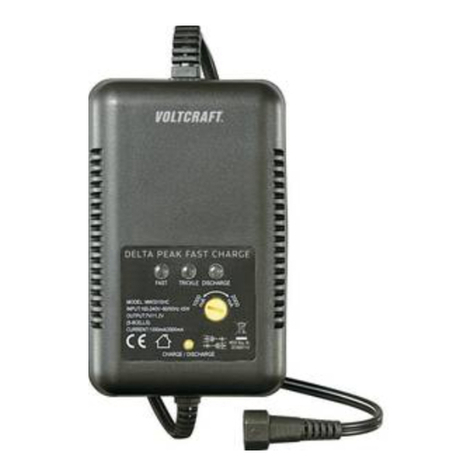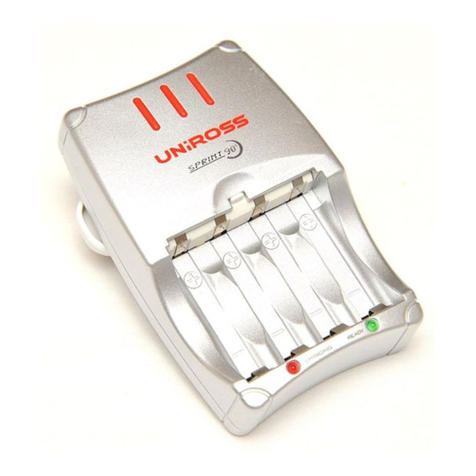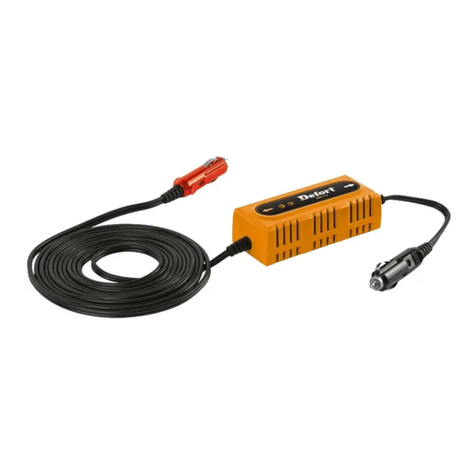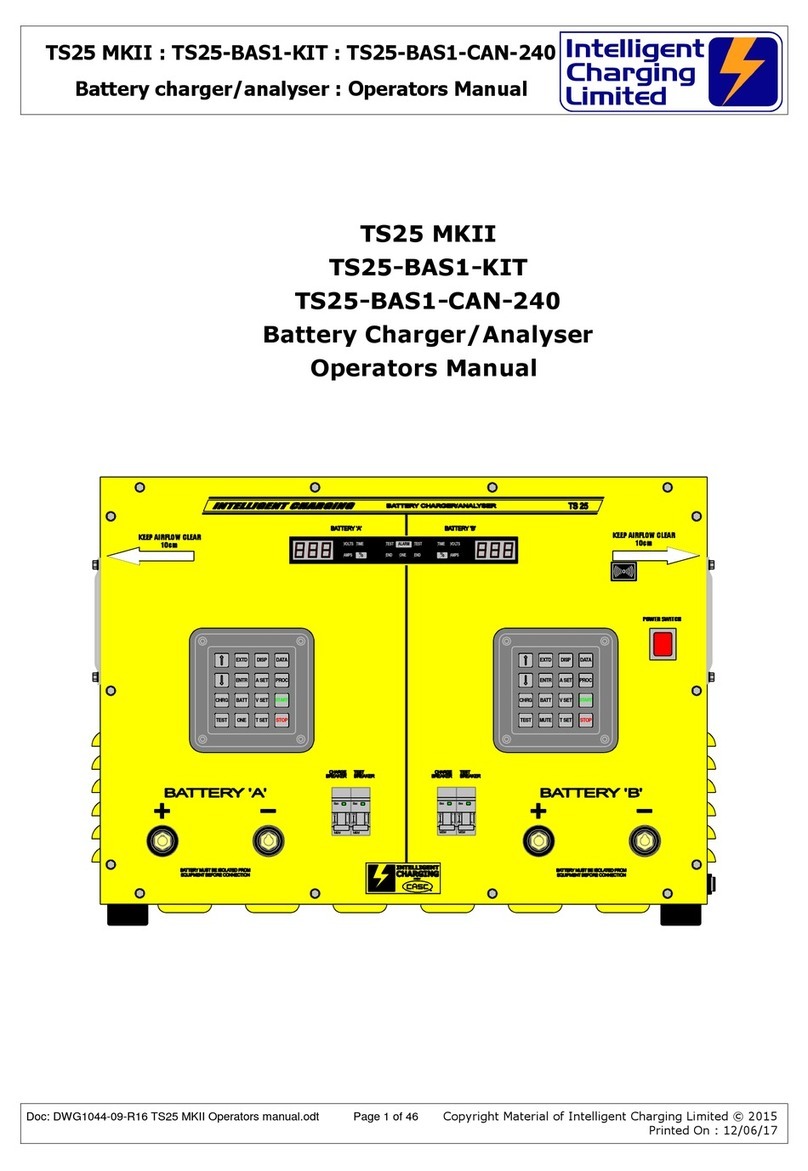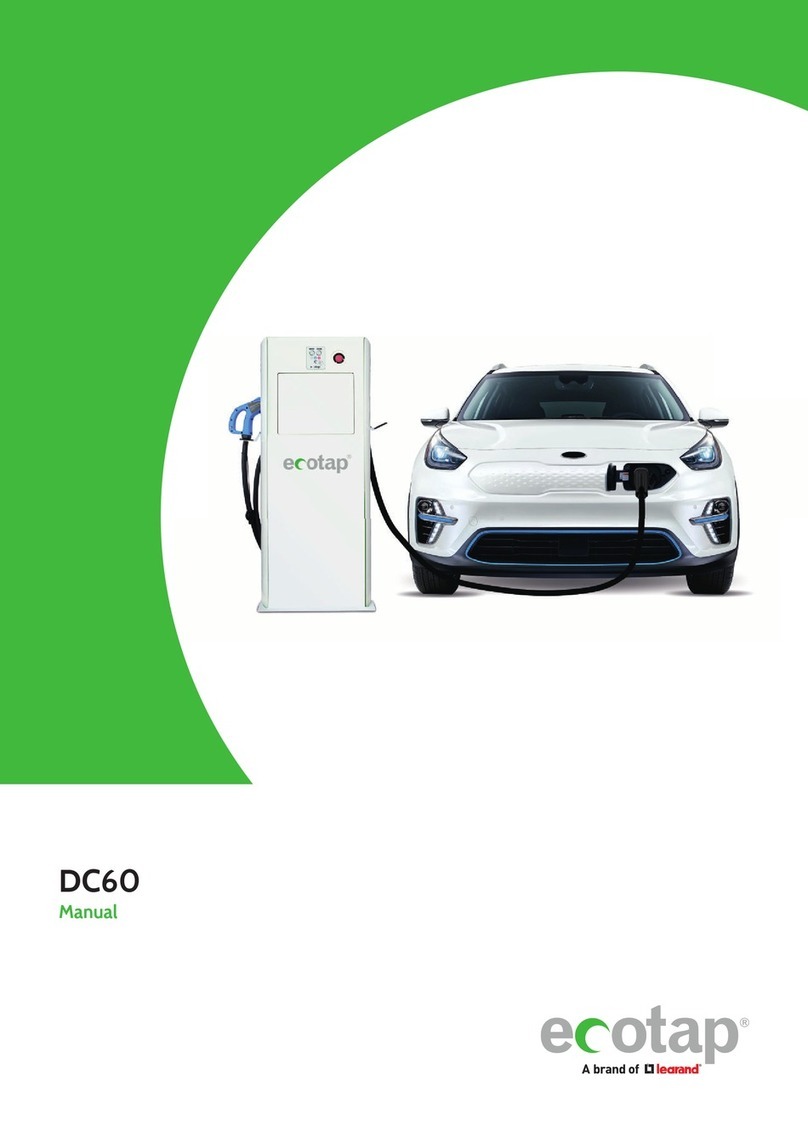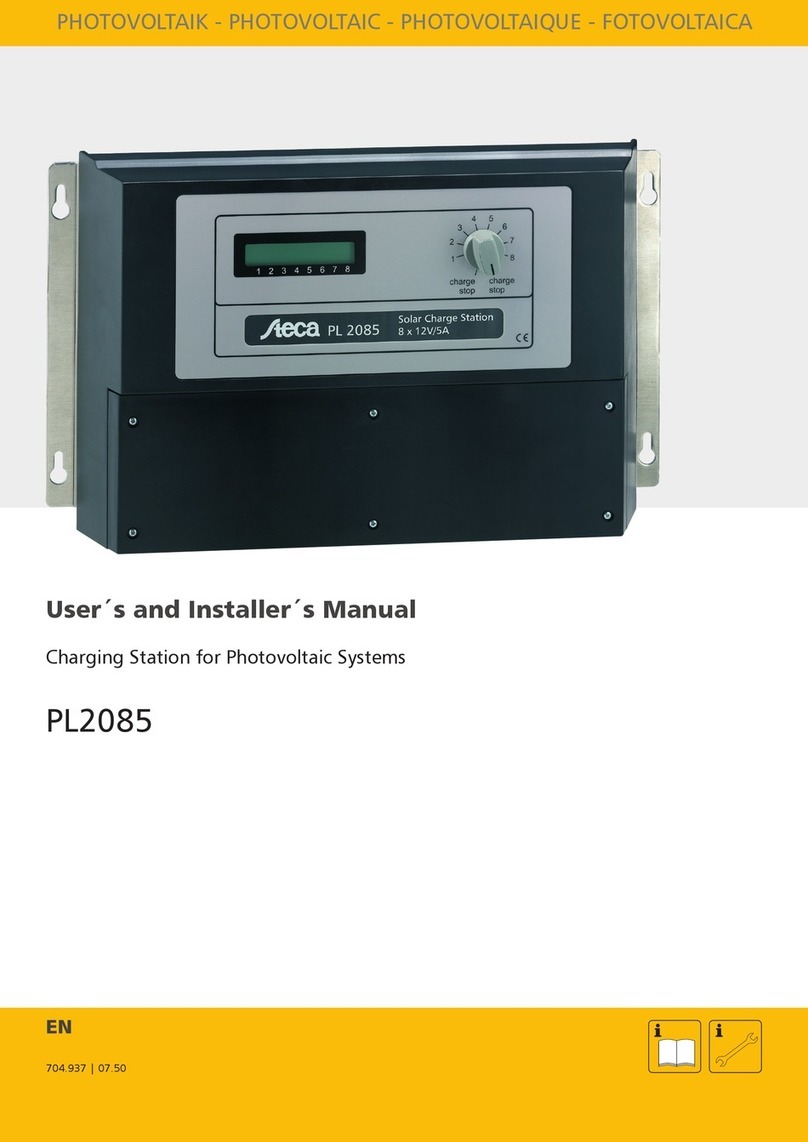GreenWorks Commercial GC 420 User manual

Read all safety rules and instructions carefully before operating this tool.
Owner’s Manual
TOLL-FREE HELPLINE: 1-855-470-4267
www.greenworkscommercial.com
82V LITHIUM-ION BATTERY CHARGER
GC 420


2
CONTENTS
Product Specications ......................................................................................................... 2
Important Safety Instructions .............................................................................................. 3
Symbols............................................................................................................................... 5
Know Your Charger.............................................................................................................. 6
Operation............................................................................................................................. 7
Maintenance ........................................................................................................................ 9
Troubleshooting................................................................................................................... 10
Limited Warranty.................................................................................................................... 11
PRODUCT SPECIFICATIONS
COMPONENTS SPECIFICATIONS
Charger 82V Lithium-ion Battery Charger
Model GC 420
Input 120V AC, 50/60Hz, 5A
Output 82V DC, 4A
Weight 2.47 lbs (1.12kg)

3
IMPORTANT SAFETY INSTRUCTIONS
IMPORTANT SAFETY INSTRUCTIONS – SAVE
THESE INSTRUCTIONS
DANGER – TO REDUCE THE RISK OF FIRE OR
ELECTRIC SHOCK, CAREFULLY FOLLOW THESE
INSTRUCTIONS
Read and understand all instructions before using this product. Failure to follow all instructions
listed below may result in electric shock, re, and/or serious personal injury.
WARNING
FOR INDOOR USE ONLY.
CAUTION
Risk of Electric Shock.
Dry location use only.
Store indoors, and do not expose to rain or water, avoid direct sunshine.
CAUTION
RISK OF FIRE OR ELECTRIC SHOCK, DO NOT INTERCONNECT OUTPUT TERMINATIONS.
CAUTION
CHARGE ONLY RECHRGEABLE BATTERY PACK GL 200, GL 250, GL 300, GL 400, GL 500,
GL 900, OTHER TYPES OF BATTERIES MAY BURST CAUSING PERSONAL INJURY AND
DAMAGE.
DANGER
RISK OF ELECTRIC SHOCK. DO NOT TOUCH UNINSULATED PORTION OF OUTPUT
CONNECTOR OR UNINSULATED BATTERY TERMINAL.
• SAVE THESE INSTRUCTIONS - This manual contains important safety and operating
instructions for battery charger GC 420.
• Before using battery charger, read all instructions and cautionary markings on battery
charger, battery, and product using battery.
• To reduce the risk of re and electric shock, install in a temperature- and humidity-controlled
indoor area relatively free of conductive contaminants.
• Use of an attachment not recommended or sold by the battery charger manufacturer may
result in a risk of re, electric shock, or injury to persons. Following this rule will reduce the
risk of electric shock, re, or serious personal injury.
• Do not abuse cord or charger. Never use the cord to carry the charger. Do not pull the charger
cord rather than the plug when disconnecting from receptacle. Damage to the cord or charger

4
IMPORTANT SAFETY INSTRUCTIONS
could occur and create an electric shock hazard. Replace damaged cords immediately.
• Do not operate charger if it has received a sharp blow, been dropped, or otherwise damaged
in any way. Take it to an authorized serviceman for electrical check to determine if the charger
is in good working order.
• Do not cover the ventilation slots on the top of the charger. Do not set the charger on a soft
surface i.e. blanket, pillow. Keep the ventilation slots of the charger clear.
• Do not probe the charger with conductive materials.
• Do not disassemble charger. Take it to an authorized serviceman when service or repair is
required. Incorrect reassembly may result in a risk of electric shock or re.
• Disconnect charger from the power supply when not in use. This will reduce the risk of electric
shock or damage to the charger if metal items should fall into the opening. It also will help
prevent damage to the charger during a power surge.
• Do not use a damp cloth or detergent to clean the battery or battery charger. Clean / wipe
down with a dry cloth.
• Do not allow the battery pack or charger to overheat. If they are warm, allow them to cool
down. Recharge only at room temperature.
• Unplug the charger before cleaning and when there is no battery pack in the charger.
• Do not try to connect two chargers.
• Do not allow liquid inside the charger.
• Do not try to use the charger for any other purpose than what is presented in this manual.
• Save these instructions. Refer to them frequently and use them to instruct others who may
use this tool. If you loan someone this tool, loan them these instructions also to prevent
misuse of the product and possible injury.
• Conrm the voltage in each country before using the charger.
• If the shape of the plug does not t the power outlet, use an attachment plug adaptor of the
proper conguration for the power outlet.
CALIFORNIA PROPOSITION 65
WARNING
This product and some dust created by power sanding, sawing, grinding, drilling, and other
construction activities may contain chemicals, including lead, known to cause cancer, birth defects
or other reproductive harm. Wash hands after handling.

5
SYMBOLS
Some of the following symbols may be used on this product. Please study them and learn their
meaning. Proper interpretation of these symbols will allow you to operate the product better and safer.
SYMBOL NAME DESIGNATION/EXPLANATION
V Volts Voltage
Hz Hertz Frequency (cycles per second)
W Watts Power
Direct Current Type or a characteristic of current
Wet Conditions Alert Do not expose to rain or use in damp locations.
Read The Operator’s Manual
To reduce the risk of injury, user must read and
understand operator’s manual before using
this product.
Safety Alert Precautions that involve your safety.
The following signal words and meanings are intended to explain the levels of risk associated
with this product.
DANGER Indicates an imminently hazardous situation, which, if not
avoided, will result in death or serious injury.
WARNING Indicates a potentially hazardous situation, which, if not avoided,
could result in death or serious injury.
CAUTION Indicates a potentially hazardous situation, which, if not avoided,
may result in minor or moderate injury.
CAUTION (Without Safety Alert Symbol) Indicates a situation that may
result in property damage.
SYMBOL SIGNAL MEANING

6
KNOW YOUR CHARGER
The safe use of this product requires an understanding of the information on the product and in
this operator’s manual as well as a knowledge of the project you are attempting. Before using
this product, familiarize yourself with all operating features and safety rules.
Power Cord
Electrical Contacts
LED Light
Cooling Air Port
Safety Lock-out Button

OPERATION
7
This device complies with Part 15 of the FCC Rules. Operation is subject to the following two
conditions:
(1) This device may not cause harmful interference.
(2) This device must accept any interference received, including interference that may cause
undesired operation.
WARNING
Changes or modifications to this unit not expressly approved by the party responsible for
compliance could void the user’s authority to operate the equipment.
NOTE: This equipment has been tested and found to comply with the limits for a Class B digital
device, pursuant to Part 15 of the FCC Rules.
These limits are designed to provide reasonable protection against harmful interference in a
residential installation. This equipment generates, uses and can radiate radio frequency energy
and, if not installed and used in accordance with the instructions, may cause harmful interference
to radio or television reception, which can be determined by turning the equipment off and on, the
user is encouraged to try to correct the interference by one or more of the following measures:
– Reorient or relocate the receiving antenna.
– Increase the separation between the equipment and the receiver.
– Connect the equipment into an outlet on a circuit different from that to which the receiver is
connected.
– Consult the dealer or an experienced radio/TV technician for help.
WARNING
Do not allow familiarity with products to make you careless. Remember that a careless fraction of a
second is sufcient to inict serious injury.
WARNING
Do not use any attachments or accessories not recommended by the manufacturer of this product.
The use of attachments or accessories not recommended can result in serious personal injury.
CAUTION
Charge in a well ventilated area. Do not block charger vents. Keep them clear to allow proper
ventilation.

8
OPERATION
CHARGING PROCEDURE
NOTE: The battery is not shipped fully charged. It is recommended to fully charge before rst
use to ensure that maximum run time can be achieved. This lithium-ion battery will not develop a
memory and may be charged at any time.
Low voltage charging:
If the battery has been stored with little to no charge for a long period of time, the charger will go
into recovery mode, which will take 20 hrs to fully charge the battery. This will enhance the life of
the battery. Once it is fully charged, the next charge will return to standard charging.
A fully discharged battery pack will require approximately 30 minutes (2Ah) to fully charge from a
discharged state.
1. Charge one battery:
– Plug the charger (1) into an AC power outlet.
– Insert the battery pack (2) into the charger (1).
2. Charge two batteries:
– Plug the charger (1) into an AC power outlet.
– Insert two battery packs (2) into the charger (1).
Note: When charging two battery packs, the two batteries are charged separately. The charger
will charge one battery rst. After one battery is fully charged, it will charge the other battery.
This is a diagnostic charger. The Charger LED Lights (3) will illuminate in specic order to
communicate the current battery status. They are as follows:
Charging Fully
Charged Over
Temperature Charging
Fault
LED STATUS DESCRIPTION
Blinking Green Charging
Solid Green Fully Charged
Solid Red Over Temperature
Blinking Red Charging Fault
2
1
3
False defect note:
When the battery is inserted into the charger and the status LED blinks RED, remove the battery
from the charger for 1 minute, then reinsert. If the status LED blinks GREEN, then the battery
is properly charging. If the status LED is still blinking RED, remove the battery and unplug the
charger for 1 minute. After 1 minute, plug in the charger and reinsert the battery. If the status
LED blinks GREEN, then the battery is properly charging. If the status LED is still blinking RED,
the battery is defective and needs to be replaced.

9
MAINTENANCE
WARNING
To avoid serious personal injury, always remove the battery pack from the tool when cleaning or
performing any maintenance.
WARNING
When servicing, use only identical GW replacement parts. Use of any other parts may create a
hazard or cause product damage.
WARNING
It is not recommended to use compressed dry air as cleaning method of the charger. If cleaning
with compressed air is the only method to apply, always wear safety goggles or safety glasses with
side shields when using compressed air to clean the tool. If the operation is dusty, also wear a dust
mask.
GENERAL MAINTENANCE
• Brush or blow dust and debris out of the air vents using compressed air or a vacuum. Keep
the air vents free of obstructions, sawdust, and wood chips. Do not spray, wash, or immerse
the air vents in water.
• Wipe off the housing and the plastic components using a dry, soft cloth. Do not use strong
solvents or detergents on the plastic housing or plastic components. Certain household
cleaners may cause damage and may cause a shock hazard.
STORAGE
• Always remove the battery pack before storing the charger or any time the charger is
unplugged.
• Do not place the battery pack in the sun or in a warm environment. Keep at normal room
temperature.
• If the battery will not be used for 3 months or more, please store the battery in a room
temperature environment. Please fully charge before storage.
WARNING
Do not at any time let brake uids, gasoline, petroleum-based products, penetrating oils, etc. to
come in contact with plastic parts. Chemicals can damage, weaken or destroy plastic which may
result in serious personal injury.Chemicals can damage, weaken or destroy plastic which may result
in serious personal injury.

TROUBLESHOOTING
10
PROBLEM CAUSE SOLUTION
Charger doesn't work. Charger
shows defective mode (LED
ashes Red).
Battery pack or charger is
defective or bad connection
between the battery pack and
charger.
1. Try to remove and reinsert
the battery pack in the
charger.
2. Try charging a different
battery pack.
3. Unplug the charger and wait
until the red LED goes out,
then reconnect the plug to
the power supply.
Charger doesn't work. Charger
shows evaluative mode (LED
indicates Red solid ON).
Battery pack is too hot or too
cold.
Allow the battery pack to reach
normal temperature. Charging
will begin when battery
pack returns to 3°C-47°C
(37°F-117°F).

LIMITED WARRANTY
GREENWORKS charger hereby warranties this product, to the original purchaser with proof of
purchase, for a period of two (2) years against defects in materials, parts or workmanship.
GREENWORKS, at its own discretion will repair or replace any and all parts found to be defective,
through normal use, free of charge to the customer. This warranty is valid only for units which have
been used for personal use that have not been hired or rented for industrial/ commercial use, and
that have been maintained in accordance with the instructions in the owners’ manual supplied with
the product from new.
2 Year Limited Power Train Warranty Coverage:
– Motor
– PCB Boards
– Gear Box
– 2 years from the date of purchase (non transferable)
Warranty Exclusions, Limitations and Rights:
1. All warranties may not be transferred by the consumer to any subsequent
purchaser.
2. Parts or components not supplied by the warrantor, or parts or components that
have been modied.
3. Any failure resulting from the use of improper tools or improper repair procedures.
4. Any failure or part that has become inoperative due to accident, impact, abuse,
misuse, neglect, mishandling, dulling of cutting edges, or failure to operate the
product in accordance with the information provided in the instruction manual
supplied with the product.
5. Normal deterioration of the exterior due to use or exposure, and any repairs made
necessary by normal wear, improper maintenance, improper lubrication, improper
storage, dirt, abrasives, impact, moisture, water, rain, snow, rust, corrosion,
varnish, or other similar conditions.
6. Routine maintenance items such as lubricants, blade sharpening.
7. The unit, if it has not been operated and/or maintained in accordance with the
owner’s manual.
8. Improper voltage for electric products and batteries that have been exposed to
temperatures beyond those specied in the product’s instruction manual, batteries
that have not been properly charged or batteries that have reached their useful life.
11

LIMITED WARRANTY
GREENWORKS HELPLINE:
Warranty service is available by calling our toll-free helpline, at 1-855-470-4267.
TRANSPORTATION CHARGES:
Transportation charges for the movement of any power equipment unit or attachment are the
responsibility of the purchaser. It is the purchaser’s responsibility to pay transportation charges
for any part submitted for replacement under this warranty unless such return is requested in
writing by GREENWORKS.
12

TOLL-FREE HELPLINE: 1-855-470-4267
Rev: 00 (16-11-17)
Greenworks Tools
P.O. Box 1238
Mooresville, NC 28115

Avant d’utiliser le produit, veuillez lire et suivre toutes les consignes de
sécurité et les instructions d’utilisation.
Guide D’utilisation
LIGNE D’ASSISTANCE SANS FRAIS: 1-855-470-4267
www.greenworkscommercial.com
CHARGEUR DE BATTERIE LITHIUM-ION 82V
GC 420

2
MATIÈRES
Fiche Technique................................................................................................................... 2
Consignes De Sécurité Importantes .................................................................................... 3
Symboles............................................................................................................................. 5
Veiller À Bien Connaître Votre Chargeur ............................................................................. 6
Utilisation............................................................................................................................. 7
Entretien .............................................................................................................................. 9
Dépannage.......................................................................................................................... 10
Garantie Limitée.............................................................................................................. 11
FICHE TECHNIQUE
COMPOSANT CARACTÉRISTIQUES
Chargeur Chargeur De Batterie Lithium-ion 82V
Modèle GC 420
Entrée 120V AC, 50/60Hz, 5A
Sortie 82V DC, 4A
Piods 2,47 lbs (1,12kg)

3
CONSIGNES DE SÉCURITÉ IMPORTANTES
CONSIGNES DE SÉCURITÉ IMPORTANTES –
CONSERVEZ CES INSTRUCTIONS
DANGER – POUR RÉDUIRE LES RISQUES
D’INCENDIE OU DE DÉCHARGE ÉLECTRIQUE,
SUIVEZ SCRUPULEUSEMENT CES INSTRUCTIONS
Lire et veiller à bien comprendre toutes les instructions. Le non-respect de toutes les
instructions ci-dessous peut entraîner un choc électrique, un incendie et/ou des blessures
graves.
AVERTISSEMENT
POUR UNE UTILISATION À L’INTÉRIEUR EXCLUSIVEMENT.
ATTENTION
Risque de choc électrique.
Utilisez l’unité uniquement dans un endroit sec.
Entreposer à l’intérieur et protéger de la pluie ou de l’eau, éviter une exposition directe à la lumière
du soleil.
ATTENTION
RISQUE D’INCENDIE ET D’ÉLECTROCUTION, NE CROISEZ PAS LES BORNES DE
SORTIE.
ATTENTION
CHARGEZ UNIQUEMENT LA BATTERIE RECHARGEABLE GL 200, GL 250, GL 300, GL
400, GL 500, GL 900, LES AUTRES TYPES DE BATTERIES POURRAIENT EXPLOSER,
MAIS AUSSI CAUSER BLESSURES ET DOMMAGES.
DANGER
RISQUE DE CHOC ÉLECTRIQUE. NE PAS TOUCHER LES PARTIES NON ISOLÉES DU
CONNECTEUR DE SORTIE OU LES BORNES DE PILES NON ISOLÉES.
• CONSERVEZ CES INSTRUCTIONS - Ce manuel contient d’importantes instructions
relatives à la sécurité et au fonctionnement des chargeur de piles GC 420.
• Avant d’utiliser le chargeur de piles, lire toutes les instructions et les mises en garde gurant
sur le chargeur de pile, sur la pile et sur le produit utilisant la pile.
• An de réduire les risques d’incendie et d’électrocution, installez l’outil dans une pièce dont la
température et l’humidité sont contrôlées, et ne présentant aucun contaminant conducteur ou
libre.
• L’usage d’un accessoire non recommandé ou vendu par le fabricant du chargeur peut causer

4
CONSIGNES DE SÉCURITÉ IMPORTANTES
un risque d’incendie, de choc électrique ou de blessures. Le respect de cette consigne
réduira les risques d’incendie, de choc électrique et de blessures graves.
• Ne pas maltraiter le cordon d’alimentation ou le chargeur. Ne jamais utiliser le cordon
d’alimentation pour transporter le chargeur. Ne pas débrancher le chargeur en tirant sur le
cordon. Tirer sur la che pour la débrancher. Un cordon ou un chargeur endommagé peut
présenter un risque de choc électrique. Remplacer immédiatement tout cordon endommagé.
• Ne pas utiliser le chargeur s’il a été soumis à un choc violent ou autrement endommagé. Le
coner à un réparateur agréé an qu’il détermine s’il est en bon état de fonctionnement.
• Ne couvrez pas les fentes de ventilations situées sur le dessus du chargeur. Ne posez pas le
chargeur sur une surface souple, telle qu’une couverture ou un oreiller. Gardez les fentes de
ventilation du chargeur dégagées.
• N’introduisez pas de matériaux conducteurs dans le chargeur.
• Ne pas démonter le chargeur. Si un entretien ou une réparation est nécessaire, le coner à un
réparateur agréé. Un remontage incorrect peut entraîner des risques de choc électrique ou
d’incendie.
• Lorsqu’il n’est pas en usage, débrancher le chargeur de l’alimentation secteur. Ceci réduira
le risque de choc électrique ou de dommages au chargeur si des articles en métal venaient à
tomber dans l’ouverture. Ceci aidera également à éviter des dommages au chargeur en cas
de saute de tension.
• Ne pas utiliser de tissu humide ni de détergent sur la pile ni sur le chargeur de la pile.
Nettoyez / essuyez avec un chiffon sec.
• Ne laissez pas la batterie ou le chargeu r surchauffer. S’ils sont chauds, laissez-les refroidir.
Ne procédez à la charge qu’à température ambiante.
• Débranchez le chargeur avant de le nettoyer et lorsqu’aucune batterie n’y est connectée.
• Ne tentez de relier deux chargeurs ensemble.
• Ne laissez aucun liquide pénétrer dans le chargeur.
• Ne tentez pas d’utiliser le chargeur dans tout autre but que celui décrit dans ce manuel.
• Conserver ces instructions. Les consulter fréquemment et les utiliser pour instruire les autres
utilisateurs éventuels. Si cet outil est prêté, il doit être accompagné de ces instructions, an
d’éviter un usage incorrect et d’éventuelles blessures.
• Conrmez la tension secteur disponible dans chaque pays avant d'utiliser le chargeur.
• Si les broches de la fiche secteur ne rentrent pas dans la prise, utilisez un adaptateur
correspondant à la conguration de la prise secteur.
PROPOSITION 65 DU GOUVERNEMENT DE CALIFORNIE
ATTENTION
Ce produit et certaines poussières provenant du sablage, du sciage, du meulage, du perçage
et d’autres activités de constructions vous exposent à des substances chimiques (en incluant
le plomb) bien connues de l’État de Californie et pouvant causer des cancers, des défauts de
naissance ou autres maladies. Lavez-vous les mains après manipulation.

5
SYMBOLES
Certains des symboles ci-après sont susceptibles de gurer sur cet appareil. Etudiez-les et apprenez
leur signi cation. Une interprétation correcte de ces symboles vous permettra d’utiliser votre appareil
dans de meilleures conditions de sécurité et de manière plus adéquate.
SYMBOLE NOM DÉSIGNATION/EXPLICATION
V Volts Tension
Hz Hertz Fréquence (cycles par seconde)
W Watts Alimentation
Courant continu Type ou caractéristique du courant
Alerte à l’humidité Ne pas exposer l’outil à la pluie ou utiliser dans
un environnement mouillé.
Lisez le guide d’utilisation
Pour réduire le risque de blessure, les
utilisateurs doivent lire et comprendre le guide
d’utilisation avant d’employer ce produit.
Alerte de sécurité Précautions touchant à votre sécurité.
Les termes de mise en garde suivants et leur signication ont pour but d’expliquer le degré de
risques associé à l’utilisation de ce produit.
DANGER Indique une situation extrêmement dangereuse qui, si elle
n’est pas évitée, entraînera des blessures graves ou mortelles.
AVERTISSEMENT Indique une situation potentiellement dangereuse qui, si elle
n’est pas évitée, pourrait entraîner des blessures graves ou
mortelles.
ATTENTION Indique une situation potentiellement dangereuse qui, si elle
n’est pas évitée, pourrait entraîner des blessures légères ou
de gravité modérée.
ATTENTION (Sans le symbole Alerte à la sécurité) Indique une situation qui
pourrait entraîner des dommages matériels.
SYMBOLE SIGNAL SIGNIFICATION

6
VEILLER À BIEN CONNAÎTRE VOTRE CHARGEUR
Pour utiliser ce produit en toute sécurité, vous devez comprendre les renseignements gurant
sur l’outil et dans le présent guide d’utilisation, et vous devez avoir de bonnes connaissances
au sujet du projet que vous allez entreprendre. Avant d’utiliser ce produit, familiarisez-vous avec
toutes ses caractéristiques et avec les règles de sécurité qui s’y rapportent.
Cordon D’alimentation
Contacts Électriques
Lampe À DEL
Arrivée D’air De Refroidissement
Bouton de verrouillage de sécurité
Table of contents
Languages:
Other GreenWorks Commercial Batteries Charger manuals

